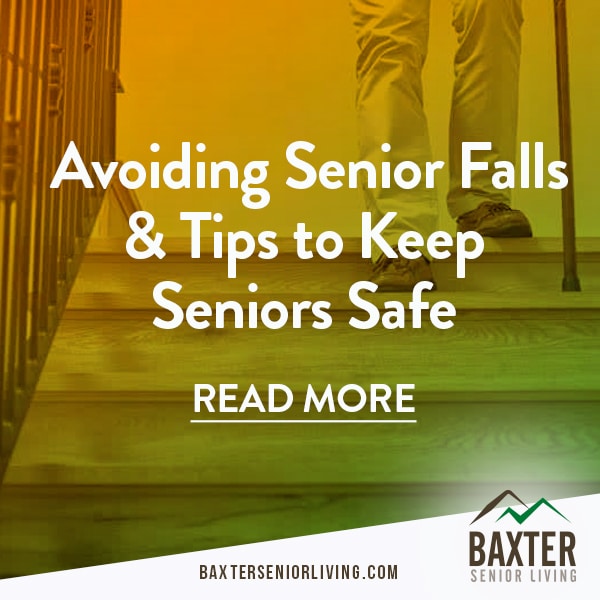Senior falls can result in significant injuries. In addition to lacerations, fractures, and broken bones, head trauma could even result in loss of life. A hip injury could trigger a downward spiral for a senior’s health and future independence.
Seniors who suffer from falls have a much higher probability of falling again in the following months. In addition, victims of a past accident may become so terrified of it happening again that it may negatively affect their quality of life and mental health.
The fear may limit the physical activity that brings a senior joy, health, and social connection.
Many factors affect the fall risk level that older adults face, which tends to increase with age. Fortunately, a few simple steps can dramatically lower the chance of suffering a trip or fall.
How Can You Reduce Senior Fall Risk?
Identifying trip hazards in the home is vital for elderly persons who choose to age in place. A friend or family member should walk around the house and note any potential dangers that can be eliminated. For example, clutter is a frequent cause of senior falls, so remove any objects, wires, or cables obstructing walking areas. If you are helping an elderly loved one make their home safer, ask them to help by listing the items they use most regularly. These items should all be positioned in places that are easily accessible without balancing precariously to reach them. Here are a few ideas:
- Small tables and ornamental items are not worth the risk of stumbling over, however lovely they look.
- Well-built shoes are a must, with good soles. Footwear with heels, slippers, and shoes with poor grip pose a serious threat to safety.
- Rugs and carpets are another significant cause of senior falls. If they must have either of these in their home, they must be in good shape and solidly secured to the floor. If a carpet or rug is free to move around, the fabric will start to bunch up, leading to a raised flap that can easily be tripped over.
- Loose floorboards must be fixed immediately. Consider a professional modification for any doorway threshold that is raised enough to pose a trip hazard. Installing nonslip treads will add much-needed grip to wooden stairs.
- Don’t forget to assess the exterior parts of the senior’s property that they frequently access.
- Good lighting is essential, so seniors can visually identify hazards quickly. This is especially important for those with poor eyesight.
- Lamps and night lights should be strategically placed in all the high-risk areas of the home, like stairs and hallways. In the bedroom, a lamp or light switch should be placed within easy reach of the bed. Don’t forget to have plenty of flashlights that are easy for them to locate in the event of a power cut.
- Any liquid accidents or food and drink spilled on the floor should be cleaned up quickly, so they won’t slip.
What Can You Add To The Home To Lower Fall Risk?
The bath or shower is a hot zone for fall-based injuries. Bath seats are safe additions that considerably lower the risk of slipping as one takes a wash. A nonslip bath mat with a good solid grip will also reduce the potential risk of falling.
Assistive devices and adaptive technologies are indispensable additions to ensure that seniors remain safe if they struggle with some tasks. For example, grab bars can be installed for the toilet, shower/bath. A raised toilet seat with handles is also a great bathroom addition.
It’s a good idea for family members to observe older adults in their homes and look out for any activity that appears to be a challenge. Then, consult health professionals and research technology online with a proven track record for helping with any activity.
If a walking cane, walker, or other mobility device is recommended, urge your loved one to accept the suggestion and stay safe.
How Does Health Affect The Risk Of A Fall?
Eyesight
Please ensure a senior keeps up with regular eye exams in case their vision changes and they need a stronger prescription. It’s a good idea for those 65+ to have a complete exam every 1-2 years. The visits should be more frequent if they need glasses or have a health condition affecting the eyes (like diabetes).
Sarcopenia
Sarcopenia is a contributing factor that involves the loss of muscle (and bone) and is a normal consequence of aging. Strength training exercises greatly benefit seniors, especially activities that strengthen the legs. Exercises that improve coordination and balance are also highly beneficial for reducing fall risk.
Exercise
If they fear falling during exercise, a supervised program may be more appropriate until they are confident enough to exercise alone. In some cases, physical therapy may also be required to ensure safe physical activity. A senior should consult their doctor before attempting anything strenuous. In general, lighter exercises like walking are safer to start with to build muscular strength.
Medical Conditions
Diseases like Parkinson’s and Alzheimer’s may contribute to home injuries and other health factors. Any medical condition affecting the body or mind can also raise the risk.
Alcohol Consumption
Older adults who consume alcohol should be encouraged to cease or moderate their intake. Any amount will increase the risk since it acts directly on the central nervous system. In addition, when combined with medications, the sedating effects of alcohol can compound the chance of falling.
How Do Medications Contribute To Falls?
Prescription Medications
Prescription medications can elevate the risk of losing one’s footing. This is especially true of sedative and hypnotic drugs, antidepressants, and others. Psychoactive medications are most commonly associated with falls. These drugs (that target the brain) include benzodiazepines. According to the CDC, effective medication management is crucial for those aged 65+. In addition, a review of drug interactions, and their potential side effects, is vital to reduce the fall risk for older citizens.
Create a list of all the prescription drugs and medications that are currently being taken. Next, schedule a visit with the senior’s primary care physician so that they can explain the side effects that might increase the risk of injury. At the appointment, ensure they are honest about any recent falls, near tumbles, or any direct causes that may have contributed.
Together, you should be able to come up with a plan of action that can keep them safe at home. For example, the doctor may need a reduced dose of certain medications or try others that function differently. Managing existing or emerging medical conditions will also help minimize the chances of an accident.
Ensuring a well-balanced diet with adequate vitamin D and calcium is essential for optimal bone health. In addition, any steps that can be taken to strengthen the bones mean that the injuries will probably be less severe if they do fall.
Get the care you need at an Anchorage Assisted Living Community
At a memory care community like Baxter Senior Living, our highly trained staff will assist your loved ones with their daily living activities. We understand that each patient is different and has different care needs. Accordingly, we create individual care plans for our residents.
The decision between memory care and 24-hour in-home care is very personal. It is difficult to accept that your family members’ current situation will inevitably change. With these changes, your needs and capabilities as a caregiver will also change. Contact Baxter Senior Living today if you have reached the stage where you need help to care for your loved one.


